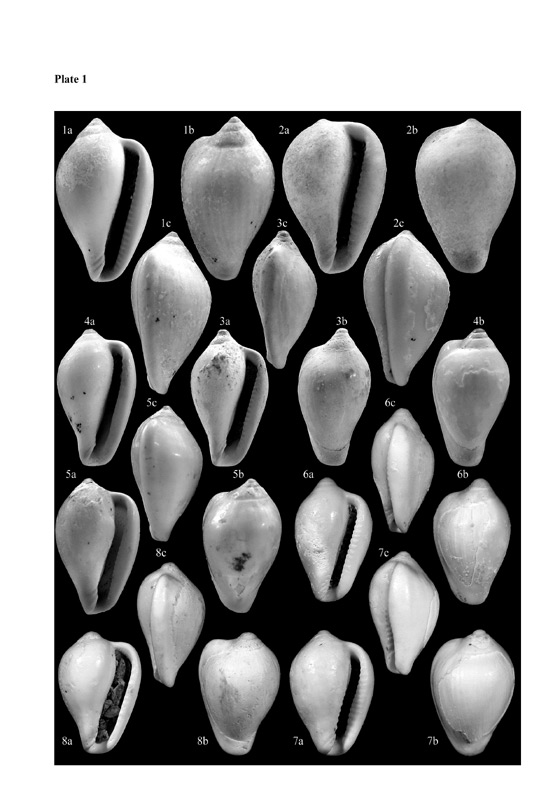
|

|
PALAEONTOS 5Price: non members: 40 euros + postage, members: 35 euros + postage Landau B. & Fehse D., 2004, The Early Pliocene Gastropoda (Mollusca) of Estepona, Southern Spain. Part 3 Trivioidea, Cypraeoidea(34 textpages, 5 textfigures, 1 table, 10 platesSummary: In this, the third part of the Gastropoda (Mesogastropoda) of the Early Pliocene (early Piacenzian) deposits of Estepona, province of Málaga, Spain, the Cypraeoidea are described and the Trivioidea listed and illustrated. The faunal composition is compared with that of the Atlantic, Mediterranean,and Paratethys and the zoogeography of the group during the Pliocene is discussed. The fauna of Estepona is one of the richest fossil or Recent European trivioidean and cypraeoidean faunas described. Most of the known Mediterranean Pliocene species occur, with a few exceptions. No new or endemic species of Cypraeoidea are described, a low level of endemism to be expected in a group showing predominantly a planktotrophic development. The generic and specific composition of the European Trivioidea and Cypraeoidea changed drastically along the course of the Neogene. Most of the rich middle Miocene fauna of Cypraeidae did not survive the Messinian salinity crisis. At the beginning of the Pliocene there was an influx of completely different species presumably from the Atlantic, via the Strait of Gibraltar, but most of the Miocene genera did not return. During the Pliocene the diversity slowly diminished as a consequence of climatic cooling in detectable extinction phases. Of the 33 species occurring in the Early Pliocene of Estepona only one survived into the Recent fauna. Landau B., Beu A. & Marquet R., 2004, The Early Pliocene Gastropoda (Mollusca) of Estepona, Southern Spain. Part 5: Tonnoidea and Ficoidea.(68 textpages, 3 textfigures, 1 table, 10 plates)Summary: In this work, the fifth in the series giving a systematic account of the Gastropoda of the Early Pliocene (Zanclean and lower Piacenzian) deposits of Estepona, province of Málaga, Spain, the Tonnoidea and Ficoidea are described and discussed, with special attention to protoconch morphology. The 23 species encountered include almost all the Mediterranean Pliocene species, although Tonna galea (Linnaeus) is present in place of the more common Eudolium stephaniophorum (Fontannes). None of the taxa are new to science. The faunal composition is compared with that of the Atlantic, North Sea basin, Mediterranean and Paratethys. Species of tonnoideans have wide geographical and time ranges, unparalleled in any other gastropod group. In contrast, the three species of Ficus are all endemic Mediterranean species. Taxa with long evolutionary lineages in the European area include Cypraecassis cypraeformis (Borson), of which C. pseudocrumena (D'Orbigny), the Pliocene form, is considered a synonym, Semicassis laevigata (Defrance) - S. saburon (Bruguière), Cymatium (Monoplex) subcorrugatum (D'Orbigny) - S. corrugatum (Lamarck) and Bufonaria (Aspa) subgranulata (D'Orbigny) - B. marginata (Gmelin). Other species remained unchanged throughout Neogene time in Europe (Ranella olearium Linnaeus, Charonia lampas Linnaeus) but extended their ranges to the Southern Hemisphere during Neogene time (C. lampas during Middle Miocene time, R. olearium during Pleistocene or Holocene time). Conversely, one species has an earlier fossil record in Central America than in Europe, and apparently was dispersed to Europe during Miocene time (Cymatium (Monoplex) parthenopeum von Salis Marschlins). Two further species have a long fossil record in the Mediterranean area and West Africa, but made brief range extensions to Central America during Late Pliocene-earliest Pleistocene time (Bursa scrobilator Linnaeus, Bufonaria (Aspa) marginata). One other now typically Mediterranean genus and species, Cabestana cutacea (Linnaeus), has no fossil record anywhere in West Africa or the Mediterranean region until Pleistocene time, and evidently arrived recently from the Southern Hemisphere. The geographical ranges of tonnoideans are highly plastic, reflecting their long-lived larval disersal phase. The name Murex cancellinus Lamarck, 1803 is adopted for the common European Miocene-Pliocene Distorsio species usually known as D. tortuosa (Borson, 1821), and a neotype proposed for M. cancellinus. On the other hand, all the Ficoidea are endemic to the European Neogene, two of the three species restricted to the Pliocene. Ficus condita (Brongniart), widely recorded in the European Pliocene literature, is found not to be this species, which is retricted to the European Miocene. F. subintermedia (D'Orbigny), the Pliocene species that has usually been known by this name, is distinguished from F. condita on the basis of protoconch morphology. Janssen A., 2004, Holoplanktonic molluscan assemblages from the Pliocene of Estepona (Spain, Málaga)(29 textpages, 4 textfigures, 4 tables, 4 platesSummary: Holoplanktonic mollusc assemblages from a number of localities near Estepona (Spain, Málaga) were found to comprise 18 species (3 heteropods, 15 pteropods). The age of the Velerín Antena conglomerates is demonstrated to be Piacenzian, samples from other (presumably higher) levels point to a Zanclean or Piacenzian age, but because of their relative position above the conglomerates must also be Piacenzian. Striking is the occurrence of several bathypelagic species such as Thielea helicoides, Peraclis bispinosa and P. triacantha, possibly explained by a turbiditic character of the Estepona Pliocene deposits, or rather indicating upwelling from deep water levels. Bellardiclio subg. n., (type species Clio cuspidata), Cavolinia landaui sp. n. and Cavolinia vendryesiana f. pliomediterranea f. n. are introduced. |
|
ORDER INFORMATION:please contact us at: palaeontos@gmail.com |
|